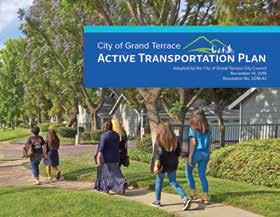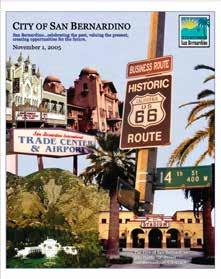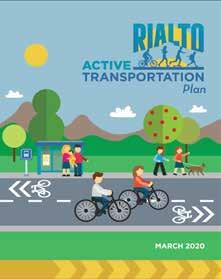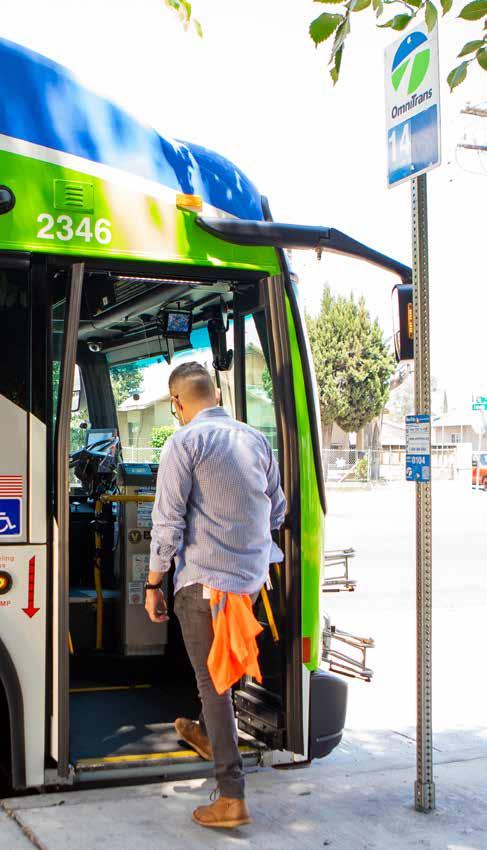
19 minute read
2.7 Policy and Planning Context
The following documents comprise the primary local and regional planning efforts affecting the Omnitrans BSSIP. The policy recommendations made within this BSSIP will take into account the following plans, which will provide context for efforts by Omnitrans, local jurisdictions, and partner agencies efforts to improve safety at and around bus stops. For each document, relevant policies, goals, and excerpts are provided.
General Plans
Advertisement
» City of Fontana General Plan5 » City of Grand Terrace General Plan6 » City of Highland General Plan7 » City of Rialto General Plan8 » City of San Bernardino General Plan9 » San Bernardino Countywide Plan and Bloomington Community Plan10
Active Transportation Plans
» Fontana Active Transportation Plan11 » Grand Terrace Active Transportation Plan12 » Rialto Active Transportation Plan
SCAG Connect SoCal
» Active Transportation Technical Report14 » Passenger Rail Technical Report » Transportation Safety and Security Technical Report » Transit Technical Report
San Bernardino County Transportation Authority
» San Bernardino County Non-Motorized Transportation Plan13 » SBCTA Improvement to Transit Access for Cyclists and Pedestrians15 » SBCTA Points of Interest Pedestrian Plan16 » Rialto Safe Routes to School Program and Plan » SBCTA Regional Safe Routes To School Plan Phase I & II


THE 2020-2045 REGIONAL TRANSPORTATION PLAN/ SUSTAINABLE COMMUNITIES STRATEGY OF THE SOUTHERN CALIFORNIA ASSOCIATION OF GOVERNMENTS
ADOPTED ON SEPTEMBER 3, 2020
2.7.1 General Plans
Fontana General Plan (2018)
In the Community Mobility and Circulation section of Fontana’s General Plan, one strategy is to create a Bus Stop Master Plan to include bus shelters and other amenities and improvements for accessing and using bus stops.
Grand Terrace General Plan (2010)
The following policies and actions included in Grand Terrace’s General plan are related to alternative transportation modes and transit:
Policy 3.5.4: The City shall work closely with the regional transit agencies to ensure that convenient and affordable bus service continues to be available to local residents.
Action: Appoint a City Council representative to Omnitrans to represent the City’s mass transit interests.
Policy 3.5.5: The City shall work with Omnitrans and SBCTA [formerly] known as SANBAG to implement a public transit system that meets the City’s need for internal circulation as well as connections to regional activity centers and inter-urban transit routes.
Goal 9.5: Provide alternative transportation modes designed to reduce vehicle miles traveled.
Policy 9.5.1: The City shall encourage alternative transportation modes, including mass transit, ride sharing, bicycles, and pedestrian transportation.
Action: Select sites with available alternative transportation services.
Implementation: Select sites that are in close proximity to mass transit lines and bikeways.
Highland General Plan (2012)
The following goals and policies from the Circulation Element in the Highland General Plan support overall transportation safety enhancements.
Goal 3.5: Promote bus service and paratransit improvements
Policy 3.5.4: Coordinate with Omnitrans to provide safe, clean and attractive bus shelters at bus stops and transfer stations.
Goal 3.4: Provide a safe circulation system.
Policy 3.4.8: Implement street design features such as the use of medians, bus turnouts and consolidated driveways to minimize mid-block traffic congestion.
Rialto General Plan (2010)
The Circulation Element of the Rialto General Plan includes the following policies related to safety, connectivity, and design:
Policy 2-12.7: Shade bus shelters and other outdoor use areas from the sun. Commercial projects along major corridors in Rialto shall incorporate at least one bus shelter, taxi stop, bicycle rack, and/or similar transportation or pedestrian features. The design of these features shall be consistent with the identity, feel, and theme of that corridor.
Policy 4-4.1: Designate and mark school bus stops at curbs within neighborhoods to create clear curbside boarding spaces for school bus passengers.
Policy 4-4.2: Review campus site plans to ensure that school bus bays, parking lots, automobile passenger pick-up and drop-off areas, bicycle sheds and paths, and pedestrian walks are designed to maximize separation of travel modes, and to minimize danger to arriving and departing students and school personnel.
Policy 4-6.2: Establish new bus turnouts along appropriate arterials based on and in coordination with local and regional transit providers’ master plan of stops.
Policy 4-6.5: Encourage clean, lighted, and convenient bus shelters and transit stops that are within walking distance of major activity areas and residential neighborhoods and along arterial roadways.
Policy 4-7.2: Achieve better integration of all transit and multimodal options at the Rialto Metrolink Station.
Policy 4-8.4: Require provision of secure bicycle storage, including bicycle racks and lockers, at the Metrolink station, public parks, schools, shopping centers, park-and-ride facilities, and other major activity centers.
Policy 5-9.6: Support Neighborhood Watch Programs.
Policy 5-9.8: Continue to provide community programs that develop positive relationships between the Rialto Police Department and community members, such as the Area Commander Program and Crime Free Multi-Housing Program, which provide a safe and secure environment for the community to discuss gang-related issues and effective solutions to help reduce crime and provide a safer living environment.
Policy 4-6.1: Support the establishment of an east-west Bus Rapid Transit line through the Valley along Foothill Boulevard.
Policy 4-6.6: Provide reliable and convenient paratransit services and other transportation service for individuals with disabilities and seniors who are unable to use fixed-route transportation systems.
Policy 4-9.1: Install sidewalks where they are missing, and make improvements to existing sidewalks for accessibility purposes. Priority should be given to needed sidewalk improvement near schools and activity centers. Provide wider sidewalks in areas with higher pedestrian volumes.
Policy 5-8.3: Continue to encourage design concepts that inhibit and discourage criminal behavior, such as Crime Prevention Through Environmental Design (CPTED) techniques. Policy 4-9.3: Provide pedestrian-friendly and safety improvements, such as crosswalks and pedestrian signals, in all pedestrian activity areas.
Policy 2-11.4: Incorporate street trees and other landscape treatments along corridors to provide sufficient shade canopy and promote pedestrian comfort.
San Bernardino General Plan
The following policies included in the San Bernardino General Plan are related to transit, reducing traffic, and improving air quality:
Policy 12.6.7: Promote the use of public transit and alternative travel modes to reduce air emissions.
Policy 12.6.6: Continue to cooperate with Omnitrans and the Rapid Transit District to expand as necessary the comprehensive mass transit system for the City to reduce vehicular travel.
Policy 14.2.12: Require that commercial and industrial uses implement transportation demand management programs consistent with the Air Quality Management Plan that provide incentives for carpooling, van pools, and the use of public transit to reduce traffic and associated noise levels in the City.
Policy 14.2.13: Work with local agencies and businesses to provide public transit services that reduce traffic and associated noise.
Policy 14.2.14: Work with public transit agencies to ensure that the buses, vans, and other vehicles used do not generate excessive noise levels.
2.7.2 Active Transportation Plans
Fontana Active Transportation Plan (2017)
The following policies included in Fontana’s Active Transportation Plan are related to safety, connectivity, and signage:
Policy 1.B.2: Identify gaps in the pedestrian and bicyclist facilities network and needed improvements to and within key activity centers such as employment centers, schools, Fontana Metrolink station, bus stops, and retail areas, and define priorities for eliminating these gaps by making needed improvements.
Policy 1.C.1: Coordinate with Omnitrans to establish appropriate designs for transit stops and station access ways. Bus stops can provide shelter from the weather, real-time arrival information, electronic signage, benches, garbage cans, and route maps. Bus stops can also become spaces to showcase public art.
Grand Terrace Active Transportation Plan (2010)
In Grand Terrace’s Active Transportation Plan, there are a number of improvements documented. These improvements include bicycle improvements which will upgrade the existing bike lane and bike route to Class II bike lanes with three-foot buffers and enhanced green pavement striping at transition areas. Additionally, four bus bay refuges will be built to prevent vehicular stacking in the travel lane, while one curbside bus stop will be installed to improve transit service along the corridor.
Rialto Active Transportation Plan (2010)
The primary goal of the Rialto Active Transportation Plan (ATP) is to encourage the use of alternative modes of transportation such as walking, bicycling, and scootering. The City’s priority is to build the non-motorized network to connect the schools along the Etiwanda Corridor to the Pacific Electric Trail and the multimodal facilities at the Rialto Metrolink Station and the citywide bus stops. The ATP also includes a first and last mile assessment targeting the conditions potentially affecting transit use levels within specified distance from high ridership locations within Rialto. The ATP evaluates how to effectively link people to and from transit stops to their origins and destinations, addressing the last mile at each end of their journey where facilities are often lacking.
Rialto Safe Routes to School Program and Plan
The Rialto SRTS Program objectives are: 1) to work with parents, students, schools, community leaders, and elected officials to create a safe and encouraging environment for students to walk or bicycle to school; and 2) to reduce greenhouse gas emission by promoting active modes of transportation that improve the health and wellbeing of the community through walking and bicycling to school. This district wide SRTS Program incorporates the best practice strategies of SRTS, commonly referred to as the “6 Es”. These “6 Es” are Education, Encouragement, Enforcement, Engineering, Evaluation, and Equity. Each “E” is meant to remove barriers that prevent students from walking and bicycling to school. The Engineering chapter was used to assist with recommendations for the Baseline Road and Riverside Avenue intersection bus stop recommendations. 2.7.3 SCAG Connect SoCal In 2020, the Southern California Association of Governments (SCAG) adopted Connect SoCal, a sustainable long range transportation plan for the vast and varied region that includes the counties of Imperial, Los Angeles, Orange, Riverside, San Bernardino, and Ventura. Connect SoCal is a regional planning document that allows public agencies responsible for implementing transportation projects to do so in a coordinated manner. This plan represents a vision for the region’s future and details existing challenges, as well as goals and strategies for a more sustainable region.
The following goals and principles from the Connect SoCal support overall transportation safety enhancements.
Goal 2: Improve mobility, accessibility, reliability, and travel safety for people and goods.
Goal 3: Enhance the preservation, security, and resilience of the regional transportation system.
Goal 6: Support healthy and equitable communities.
Principle 2: Place high priority for transportation funding in the region on projects and programs that improve mobility, accessibility, reliability and safety, and that preserve the existing transportation system.
Additionally, Connect SoCal identifies the importance of Transit Priority Areas (TPAs), which are areas located within one half mile of existing or major transit stops in the region. TPAs are where TOD can be realized by allowing higher density development with easy access to a multitude of safe and convenient transportation alternatives. Focusing regional growth in areas with planned or existing transit stops is key to achieving equity, economic and environmental goals, and ensure access to high-quality transportation.
Connect SoCal is also supported by 20 technical reports that provide additional data and material. The following technical reports were reviewed due to their relevance to this plan:
» Active Transportation Technical Report » Passenger Rail Technical Report » Transportation Safety and Security Technical Report » Transit Technical Report
The Active Transportation Technical Report outlines some of the most prominent reasons for investing in active transportation and reviews the impacts that supporting active modes can have on regional transportation mode share. This technical report also evaluates the relationship between active transportation and environmental justice, safety, demographic changes, land use, congestion, among other topics. Additionally, this technical report highlights how active transportation improvements can result in the creation of networks of high-quality sidewalks, crosswalks, and bikeways, and roadways can be made safer and more appealing for people interested in taking bicycling and walking trips.
The following strategies included in the Active Transportation Technical Report intend to reduce automobile vehicle miles traveled, support transit, and support mode shift:
Pedestrian Infrastructure
Strategy 1: Close network gaps, reduce driveway conflicts, and repair sidewalks to develop complete networks that provide access to essential destinations for users of all ages and abilities. Strategy 2: Complete ADA and similar improvements to ensure universal access for people with disabilities and those who require mobility assistance devices.
Strategy 3: Implement traffic calming and Complete Streets projects to reduce vehicle speeds and improve safety at intersections and other crossing locations.
Local Bikeway Infrastructure
Strategy 1: Develop a context sensitive low-stress bikeway network, close bikeway network gaps, and prioritize protected infrastructure (Class 1 or 4) on high stress roadways that provide access to essential destinations for users of all ages and abilities.
Strategy 4: Complete short- and long-term bike parking improvements in the form of bike racks, bike lockers or bike hubs at key destinations.
First-Last Mile Infrastructure
Strategy 1: Complete station area pedestrian, bicycle and micro-mobility improvements to improve transit access and safety.
Strategy 2: Integrate pedestrian and bicycle network projects into new station area development to ensure networks are fully built upon station openings.
Strategy 4: Coordinate the development of land use, transit and active transportation strategies in areas expecting growth.
Strategy 5: Integrate fare payment across bike share and other micro-mobility options with transit fares.
Strategy 6: Implement improvements for transporting bikes on transit and rail in the form of safety features to secure bikes on transit and rail and expand space in rail cabins for temporary trip storage.
Regional First-Last Mile Infrastructure
Strategy 1: Support long-term storage/parking for bicycles and micro-mobility options at transit stations or options for safely bringing devices on-board.
Safety Strategies
Strategy 6: Partner on regional safety campaigns to improve driver awareness of the needs and rights of vulnerable road users.
Strategy 8: Pair major infrastructure changes and enforcement activities with messaging to communicate to community members the importance of traffic safety.
Connect SoCal prioritizes ensuring the safety and mobility of the region’s residents, including drivers and passengers, transit riders, pedestrians, micro mobility users, and bicyclists. The Safety and Security Technical Report looks at a range of safety strategies required to optimize the existing system, such as Complete Streets, in order to meet the region’s economic, housing, environmental, equity, and public health goals. The goals identified in this technical report intend to improve mobility and enhance the regional transportation system include investments in infrastructure for a well preserved and resilient transportation system, as well as providing access to multiple efficient and reliable transportation choices for all users.
Some of the strategies included in the Safety and Security Technical Report to enhance safety include:
» Implementing design treatments that support safety, including but are not limited to curb extensions, bulb-outs and pedestrian refuge islands that shorten crossing distances, marked crosswalks, advanced stop bars and shark teeth, yield markings, and changing intersection geometries to improve safety » Adopting Complete Streets policies to provide safe access for all modes. » Incorporating intersection safety into the planning grant strategy. » Installing lighting surrounding crosswalks at intersections and mid-block locations to provide better visibility of pedestrians crossing streets at night. » Improving safety for aging populations » Improve bicyclist safety » Improve safety at intersections » Improve pedestrian safety
Connect SoCal Transit Technical Report
The Transit Technical Report identifies programs, and policies necessary to increase mobility and accessibility, including congestion reduction and sustainability.
In San Bernardino County, the transit vision includes a commitment to key investments such as the Arrow project, new rapid bus services and BRT capital improvements, facilitating intercounty travel, providing transit access for all travelers, and expanding commuter rail service.
The Transit Technical Report identifies goals that intend to address the mobility needs and close gaps in San Bernardino County, including:
» Promote and Coordinate Transportation Services: Promote, improve and expand information portals, ensuring multicultural strategies, embracing technology and employing mobility management tools to improve mobility and access. » Promote Safe and Comfortable Mobility: Ensure safety through new and well–maintained rolling stock, attention to passenger safety and to physical environments that promote safety for pedestrians and bicyclists.
2.7.4 Other Documents
The San Bernardino County Non-Motorized Transportation Plan (NMTP) encourages the use of alternative modes of transportation such as walking and bicycling. The plan supports the development of regional non-motorized transportation facilities that provide connectivity to more than one jurisdiction or complete gaps within the regional non-motorized transportation network or serve to provide better access to transit facilities.
The following represent the goals of the NMTP:
1. Increased bicycle and pedestrian access - Expand bicycle and pedestrian facilities and access within and between neighborhoods, to employment centers, shopping areas, schools, and recreational sites. 2. Increased travel by cycling and walking - Make bicycle and walking an integral part of daily life in San Bernardino County, particularly (for bicycle) for trips of less than five miles, by implementing and maintaining a bikeway network, providing end-of-trip facilities, improving bicycle/transit integration, encouraging bicycle use, and making bicycling safer and more convenient. 3. Routine accommodation in transportation and land use planning -
Routinely consider bicyclists and pedestrians in the planning and design of land development, roadway, transit, and other transportation facilities, as appropriate to the context of each facility and its surroundings. 4. Improved bicycle and pedestrian safety - Encourage local and statewide policies and practices that improve bicycle and pedestrian safety.
San Bernardino Countywide Plan
The following policies included in the San Bernardino Countywide Plan are related to first mile/last mile connectivity, homelessness, and healthy environments:
Policy TM-3.3: First mile/last mile connectivity. We support strategies that strengthen first/last mile connectivity to enhance the viability and expand the utility of public transit in unincorporated areas and countywide.
Policy HW-1.9: Homelessness. We address homelessness by coordinating a comprehensive countywide network of service delivery and by focusing on transitional and permanent supportive housing for the unhoused, including the chronically unhoused and near-unhoused families and individuals.
Policy HW-3.1: Healthy environments. We collaborate with other public agencies, not-for-profit organizations, community groups, and private developers to improve the physical and built environment in which people live. We do so by improving such things as walkability, bicycle infrastructure, transit facilities, universal design, safe routes to school, indoor and outdoor air quality, gardens, green space and open space, and access to parks and recreation amenities.
Bloomington Community Plan (2007)
Under the Circulation Goals and Policies section of the Bloomington Community Plan produced by San Bernardino County there are two goals stated that promote bike and pedestrian safety:
Goal 1: Ensure a safe and effective transportation system that provides adequate traffic movement while preserving the rural character of the community.
Policy 1.3: Full street improvements including paving, curbs, gutters and sidewalks shall be encouraged where necessary for public health, safety and welfare.
Goal 2: Ensure safe and efficient non-motorized traffic circulation within the community.
Policy 2.3: Where feasible, separate pedestrian/bicycle/equestrian traffic from vehicular traffic on major roadways to protect the safety of trail users.
In this report, SBCTA studied the capability of non-motorized users to access its regional transit network including Metrolink commuter rail stations in San Bernardino County along the San Bernardino Line and BRT Stations in the cities of San Bernardino and Loma Linda. This project identified existing barriers to access via non-motorized modes and proposed planning-level improvements in and around the selected stations. Ten stations were developed for analysis, which served as a model for how to implement infrastructure improvements that are designed to best serve the needs of bicyclists and pedestrians at transit stations throughout the Inland Empire.

Recommended improvements at these stations included multi-use paths, pedestrian overcrossings, proposed bike routes, and bicycle parking.
SBCTA Points of Interest Pedestrian Plan
The PIPP aims to capture important locations in need of active transportation improvements. The PIPP provides a sample pedestrian plan for each of the 25 member jurisdictions, a list of additional pedestrian sites in need of pedestrian focused improvements based on extensive data analysis, and a framework for future plans that utilizes current best practices and a suite of tools that can be used to expand the PIPP to other locations as needed.
The following objectives included in the PIPP intend to provide active transportation improvements to areas that were not adequately captured in the original bicycle-centric NMTP, the broad SBCTA Complete Streets Strategy, or the school site focused Safe Routes to School Plan (SRTSP):
Develop priority-setting guidelines that demonstrate how a jurisdiction can:
» Evaluate pedestrian needs through public-outreach and utilization of cutting-edge technologies (e.g. us of aerial photography, Google
“street view”, geographic information systems, walk audits, etc.), » Identify points of interest (excluding schools which will be addressed in the SRTSP) that would benefit from a pedestrian plan based on the evaluation of pedestrian needs, » Inventory existing pedestrian access to those points of interest, » Estimate cost-effectiveness relative to project benefits, and » Prioritize pedestrian plan projects for investment of local funds and/ or for future requests for ATP and other non-motorized funds. » Take advantage of economies of scale at the County level, reducing the need for duplicative efforts at the individual city-level by creating a Points of Interest Pedestrian Plan that not only captures the County-wide pedestrian needs of today but outlines a process that can be used in the future as needs may change. » Open additional lines of communication between public works, planning agencies, and citizens. » Incorporate the PIPP, with priority-setting guidelines and County-wide pedestrian plans for selected (to be determined though this project) priority points of interest, into the NMTP. » Make PIPP project information available to the public through the existing web based NMTP GIS application.
SBCTA Regional Safe Routes To School Plan Phase I & II
Phase I of the Regional Safe Routes to School (SRTS) Plan was created with the purpose of guiding strategic improvements to the safety and accessibility of non-motorized transportation networks around San Bernardino County schools. Phase II seeks to build upon the findings from Phase I of the Regional Safe Routes to School Plan by (1) compiling findings from field observations and student travel pattern data collected from approximately ten percent of the County’s public schools, (2) assembling an inventory of site-specific recommended school zone bicyclist and pedestrian network improvements based on these data, (3) providing resources for future implementation efforts at a regional scale, and (4) developing a strategy for collecting student travel data on a periodic basis for monitoring and modeling purposes. These resources can be used to assist local agencies in creating an effective, systematic, regionally consistent program for delivering necessary improvements to school-vicinity bicyclist and pedestrian commute networks. Engineering recommendations were reviewed where applicable to assist with bus stop recommendations.
Endnotes
1 Jacobs, J. (1992). The Death and Life of Great American Cities. 2 National Association of City Transportation Officials, Urban Bikeway Design Guide. https://nacto.org/publication/urban-bikeway-design-guide/cycle-tracks/ two-way-cycle-tracks/ 3 World Health Organization (2013). Pedestrian Safety: A Road Safety Manualffor Decision-Makers and Practitioners. https://www.who.int/publications/i/ item/pedestrian-safety-a-road-safety-manual-for-decision-makers-and-practitioners 4 A Road Safety Manualffor Decision-Makers and Practitioners. https://www. who.int/publications/i/item/pedestrian-safety-a-road-safety-manual-for-decision-makers-and-practitioners 5 General Plan Update 2015-2035 (2018). https://www.fontana.org/2632/General-Plan-Update-2015---2035 6 Grand Terrace Active Transportation Plan (2018). https://www.grandterrace-ca.gov/departments/planning_development_services/planning 7 City of Highland General Plan (2012). https://www.cityofhighland.org/191/ General-Plan 8 Rialto General Plan (2010). https://www.yourrialto.com/653/General-Plan 9 City of San Bernardino General Plan (2005). https://www.sbcity.org/cityhall/ community_development/planning/default.asp 10 Bloomington Community Plan (2007). http://countywideplan.com/bloomington/ 11 Fontana Active Transportation Plan (2017). https://www.fontana.org/3143/ Active-Transportation-Plan-ATP 12 San Bernardino County Non-Motorized Transportation Plan (2011). https:// www.gosbcta.com/wp-content/uploads/2019/10/Non-Motorized-Transportation-Plan-.pdf 13 Transportation System Active Transportation (2020). https://scag.ca.gov/ sites/main/files/file-attachments/0903fconnectsocal_active-transportation. pdf?1606001530 14 Improvement to Transit Access for Cyclists and Pedestrian (2012). https:// www.gosbcta.com/plan/transit-access-improvement-for-cyclist-pedestrians-2012/ 15 SBCTA Points of Interest Pedestrian Plan. https://www.gosbcta.com/ wp-content/uploads/2019/08/SBCTA-POI-PedestrianPlan.pdf 16 Schneider, R, et al (2021) United states fatal pedestrian crash hot spot locations and characteristics.
PAGE INTENTIONALLY LEFT BLANK





